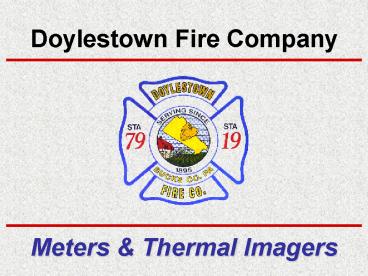Doylestown Fire Company - PowerPoint PPT Presentation
1 / 16
Title: Doylestown Fire Company
1
Doylestown Fire Company
__________________________
__________________________
Meters Thermal Imagers
2
Doylestown Fire Company uses 3 types of metering
equipment
- Industrial Scientific 4 Channel Meter
- MSA Pulsar CO meter
- TIF combustible gas leak meter
3
Industrial Scientific 4 Channel Meter
- Monitors
- Carbon Monoxide (CO)
- Hydrogen sulfide (H2S)
- Lower explosive limit (LEL)
- Oxygen (O2)
- Alarm levels
- CO 35 ppm
- H2S 10 ppm
- LEL 10
- O2
- 19 lower level
- 23 high level
4
What is carbon monoxide (CO) and how is it
produced in the home?
- Carbon monoxide
- (CO) is a colorless, odorless, poisonous gas
- Produced by the incomplete burning of solid,
liquid, and gaseous fuels. - Appliances fueled with natural gas, liquefied
petroleum (LP gas), oil, kerosene, coal, or wood
may produce CO. - Burning charcoal produces CO.
- Running cars produce CO.
5
How many people are unintentionally poisoned by
CO?
- Every year, over 200 people in the United States
die from CO - Produced by fuel-burning appliances (furnaces,
ranges, water heaters, room heaters). - Others die from CO produced while burning
charcoal inside a home, garage, vehicle or tent. - Still others die from CO produced by cars left
running in attached garages. - Several thousand people go to hospital
emergency rooms for treatment for
CO poisoning.
6
What are the symptoms of CO poisoning?
- The initial symptoms of CO poisoning are similar
to the flu (but without the fever) - They include
- Headache
- Fatigue
- Shortness of breath
- Nausea
- Dizziness
7
What CO level is dangerous to your health?
- The health effects of CO depend on the level of
CO and length of exposure, as well as each
individual's health condition. - The concentration of CO is measured in parts per
million (ppm). Health effects from exposure to CO
levels of approximately 1 to 70 ppm are
uncertain, but most people will not experience
any symptoms. Some heart patients might
experience an increase in chest pain. - As CO levels increase and remain above 70 ppm,
symptoms may become more noticeable
(headache, fatigue, nausea). - As CO levels increase above 150 to 200 ppm,
disorientation, unconsciousness, and death
are possible.
8
What is hydrogen sulfide (H2S)?
- Hydrogen Sulfide (H2S)
- Colorless gas
- Smells like rotten eggs (from the sulphur)
- Often referred to as "sewer gas
- Highly poisonous.
- Usually, the poisoning caused by hydrogen sulfide
is though inhalation and has a toxicity similar
to cyanide. - Found in petroleum and natural gas and is
sometimes present in ground water. - Natural gas can contain up to 28 H2S
gas and may be considered an air pollutant
when found near a natural gas
production area or refinery
9
H2S Levels
- Low Levels of H2S
- Odor can be perceived at levels as low as 10 ppb
(parts per billion). At levels of 50-100 ppm
(parts per million), it may cause the human sense
of smell to fail. Low levels can cause eye
irritation, dizziness, coughing, and headache. - High levels of H2S
- At high exposures (usually greater than 300 ppm),
H2S has the amazing effect of causing the nose to
stop perceiving its smell after a few
inhalations, which may lead to the inhalation of
a toxic or fatal dose (which can occur at 600
ppm). At high
levels, hydrogen sulfide gas may paralyze
the lungs, meaning that the victim
may then be unable to
escape from the toxic gas without
assistance.
10
H2S Gas
- Deaths are not uncommon when in poorly ventilated
spaces such as deep wells, underground tanks or
sewer systems. - H2S gas is heavier than air, so its concentration
is highest near the bottom of enclosed spaces
11
Industrial Scientific 4 Channel Meter
12
Industrial Scientific 4 Channel Meter
13
TIF combustible gas leak meter
14
Electric Stick / Hot Stick
15
MSA 4000 Thermal Imaging Camera
16
__________________________
__________________________































